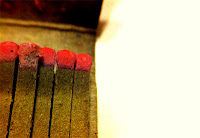 | |
| Warm temps locally force blooming cover crops |
Extended forecasts here in wine country predict day time temperatures above 60 degrees and little if any rain on the horizon. Sonoma County will see about 30" of rainfall in an average year, most of it irrigating our vineyards in the December thru February months. Season(July 1 to June 30) to date rainfall this year has been just barely around 11 inches, with most of it falling in a five(5) day period mid-January. Here at home, the last three sunny days have not been below 75 degrees, setting historical records. Most seasons we get about 5" of rain fall in February, but not this season. We will be fortunate here to do better than 1.0 inch total rainfall for this entire month. Because this is the dormant season for grapevines when they absorb most of the sustainable water they need, local vineyards have been tapping local water supplies and irrigating. And with the arrival of Spring, and its welcomed bud-break weeks away, there are sure to be watchful growers and even more water local river/reservoir usage misting potential frost damage.
 | |
| Northern Latitude mid-winter pruning of vines |
Out of Balance, too, are wines that have one or more faults, or a problem with their composition. These maladies can appear as off aromas or unappealing taste(s) in the tasters glass. Because wine is a result of chemical changes in grape juice, the precise control of these changing element levels can keep a wine in balance. However, cooked wines(lifeless or stewed) which often have been overheated or TCA 'corked' wines(aromas of wet cardboard) can be unknowingly served to the willing consumer. Of the many challenges to making good wine, there are a number chemical in-balances that remain prominent.
- Acetaldehyde is the result of oxidized ethanol(alcohol), and creates a straw-like, almost acrid character that may increase a wines complexity while keeping it unbalanced.
- Brettanomyces(Brett) which produces unpleasant aromas of barnyard or wet dog is the result of yeast spoilage.
- Mercaptans(Ethyl Mercaptan), is sulphur related, producing the malodorous scent of rotting onions, stewed cabbage or skunk.
- Fruitless and worn-out, Oxidized wines have interacted with too much air, becoming madeirised or sherry-like.
- Sulphur(SO2), the wine-making preservative, can be guilty of producing volatile aromas & flavors of burnt rubber or burnt matches. Another sulphur compound, Hydrogen Sulfide(H2S) has the odor of rotten eggs. A small amount of sulfites are produced during the natural course of fermentation.
- Volatile Acidity(VA) is vinegar-like at its worst, but mostly displayed as the result of the overproduction(higher levels) of acetic acid or ethyl acetate(a common ester), reminding most of us of nail polish remover.
 |
| Brett can smell like wet dog in the wine glass |
 |
| Over sulfured wines are a common fault |
Tannins are a natural and necessary part of a wines structure, but when presented in excess can produce a perceived fault in the wine.This compound offers complexity and a fuller body to most wines, and that is a good thing. Alcohol, too, is a needed part of any wine, as it is a byproduct of yeasts feeding on grape sugars. But this basic element can be offered in excess. When it is perceived as such, the wine will be considered out of balance. Other undesirable traits may be unsightly compounds such as sediment or tartaric crystals suspended in the wine. As these are a natural by-product of winemaking and generally benign; they may be unsightly but are usually not considered a fault that causes a wine to go out of balance.
Fermentation odors that result from wines biochemical process are obviously quite natural, however, when they are poured out of the bottle they are undesirable. Likewise, CO2, or carbon dioxide, the naturally occurring chemical compound that is a byproduct of fermentation is necessary. When it remains in the bottle of a non-sparkling wine it is described as effervescence or carbonation and may be a non-intended fault in the wine. There are some traditional 'intended' examples of this trait, such as the Vinho Verde wines of Portugal.
It is true that we do not all taste things the same, in fact it has been estimated that about 10% of the population are super-tasters. But across the range of our unique olfactory perceptions we can individually find characteristics that are unpleasant or do not seem to be appealing. Next week during the Societies exam, seven(7) glasses of the same wine will be displayed to each applicant. One of those wines will match the control sample, but the other six(6) will have a wine fault and need to be identified correctly. With the extended forecast here predicting rain on the test day, perhaps this aspiring wine educator in wine country will be seeing a positive return from being just a little out of balance!
Cheers!

No comments:
Post a Comment